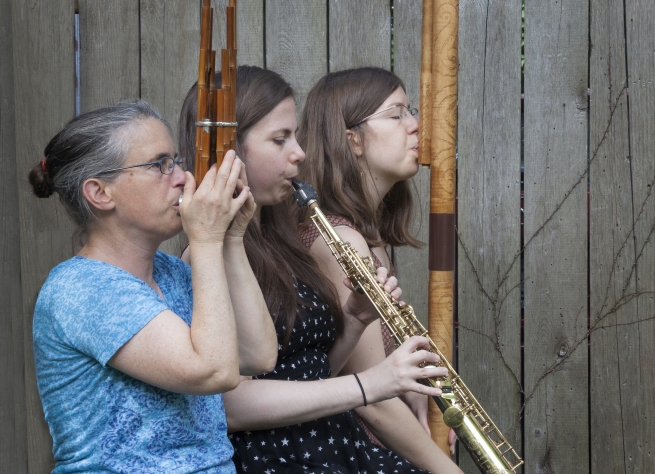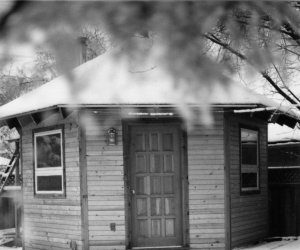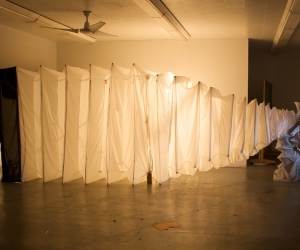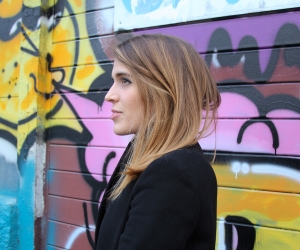
The phrase “wow and flutter” typically refers to flawed analog recordings—ones with imperfections that cause the pitch to oscillate, either slowly or quickly. When Toronto-based wind players Bea Labikova, Kayla Milmine, and Sarah Peebles decided to form an improvising trio together in late 2017, Wow & Flutter felt like the natural name choice: it’s exactly that idea of shifting pitches, and their sonic possibilities, that the musicians feel drawn to in their collaborative work.
The trio—which features Milmine on soprano saxophone, Labikova on saxophones and fujara, and Peebles on shō, cracklebox, and homemade amplification—first improvised together at an impromptu performance at Toronto’s Gerrard Art Space. Milmine has a long history of working in jazz and creative music in her hometown of Montreal, in Toronto, and in New York, where she studied with saxophonist Sam Newsome; Slovak-Canadian saxophonist Labikova brings to the group her own background in jazz, free improvisation, and Carnatic music, as well as a personal approach to the fujara, a Slovak overtone fipple flute; composer, improviser and installation artist Peebles brings decades of studying and improvising on the shō, a Japanese mouth organ rooted in Gagaku (imperial court music). Together, they perform a combination of structured and free improvisations, creating ebbing and flowing layers of sound that weave over and under one another—sometimes very slowly, sometimes rapidly.
The name has what the trio calls onomatopoeic value. “I connect it with the sound of our group, and our instruments,” says Labikova. “Since English is not my first language, I look at words that way: Kayla’s saxophone flutters a lot, and the shō does a lot of wows. Even if that’s not the original meaning.”
You can hear what she means in their music. In parts of “FlutterWow 2,” from their January 2018 session, Peebles’ shō supplies a gently swelling chordal backdrop, over which the fujara and soprano saxophone play agitated, flitting gestures.
For the group, this juxtaposition of their instruments is a visceral feeling—related to how each of them grapple with tuning, with pitch, and with breath. “Instruments that you breathe into are a kind of full-body experience,” says Milmine. “Ensembles like ours that involve only wind instruments are very interesting to me, because of the space and silence you need to take when you rely only on your breath. I really like that in music: music that can be very dense if all of us are playing, and very loud—and also at times, suddenly very spacious.”
Lately, their improvising has been leaning towards the spacious end. “My shō needs to be repaired,” Peebles confesses. “Normally I would approach it without any stopping of my breath, but my reeds won’t sound evenly if I try to play the shō normally right now. So I decided I might as well approach it a little bit differently—which creates a new opportunity for how we can respond to the music.”
Depending on the reeds installed, the shō can be played at either A-440Hz, like the saxophone, or at the much lower A-430Hz; while the fujara, as an overtone flute, uses natural harmonics to play its various pitches. The tuning across the shō, saxophones, and fujara occasionally overlaps; other times, the differences in pitch become very apparent. They don’t try to fight it.
“I actually sometimes prefer when the shō is at A-430Hz, and isn’t in the same tuning system,” says Milmine. “It almost feels like retraining our ears—that no, these sounds, which we normally wouldn’t want to hear, are interesting.”
That idea of retraining the ear resurfaces as a kind of theme in Wow & Flutter’s improvisations. Much of their music, it seems, has grown out of these instances of repurposed error: the notions of wow and flutter on records and cassettes reclaimed in live performance, or a broken instrument serving as a new type of sonic inspiration. When you listen to their music, you get that feeling sometimes—that these three players share between them a kind of total open-mindedness that makes it easy for them to occupy the same musical space. It’s an ensemble that takes nothing for granted and is exploratory to its core.
“I feel like I have to go to a really deep place when I’m improvising. It’s a good feeling, if you’re with the right people,” Milmine says, “and when I play with both Bea and Sarah, it’s very natural to go to that place with them.”
WOW AND FLUTTER OPEN FOR BRODIE WEST QUINTET'S CLIPS ALBUM LAUNCH ON SEPTEMBER 21, 8 P.M., THE MUSIC GALLERY, 918 BATHURST, TORONTO.
Photo of Wow and Flutter (Sarah Pebbles, Kayla Milmine, Bea Labikova) by Bea Labikova.
Audio: Audiopollination 61.1 Set (recorded in concert, unreleased).


